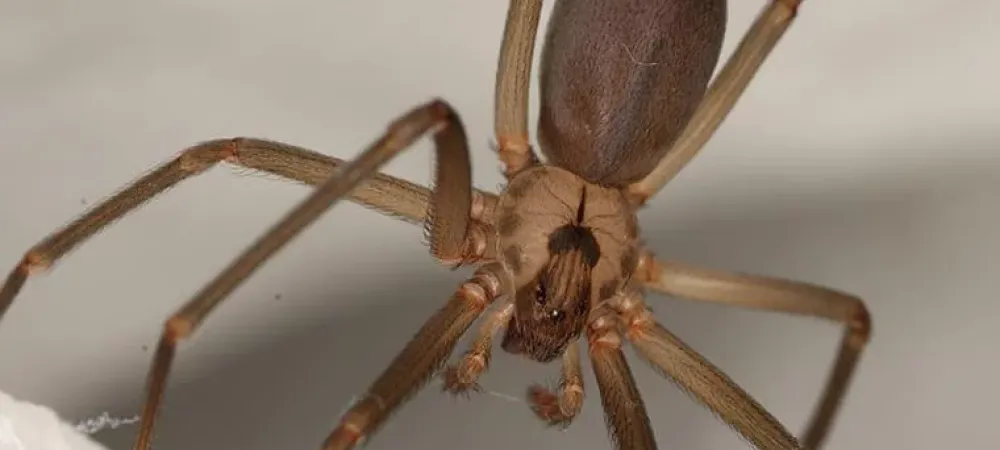Common Spiders Around Texas

Spiders have two body regions (cephalothorax and abdomen), eight legs, fangs (chelicerae), no wings, and no antennae. Most, but not all spiders have eight eyes. Spiders do not have chewing mouthparts. Instead, they use digestive enzymes in their saliva to break down their food before eating it. Spiders are arachnids and are closely related to mites, ticks, and scorpions. They are a beneficial species that feed on a wide variety of insects. Spiders come in a wide range of colors, color patterns, and sizes. Common species of spiders living in the Southeast Texas area include black widow spiders, brown recluse spiders, and daddy long legs.
Black Widow Spiders
Black widow spiders are identified by an orangish-red “hourglass” mark on the underside of their abdomen. Their round bodies are shiny-black in color.
No bigger than the size of a nickel, black widow spiders are not the largest spiders by any means. They are easily recognizable by a bulbous black abdomen with the red hourglass marking. These markings are typically on females, and those are the only ones you need to watch out for. You see, only the female black widows bite are dangerous to people. (And yes, it’s true. The females do, on occasion, eat the males after mating).
Brown Recluse Spiders
Brown recluse spiders have a distinct “violin-like” pattern on the top of their bodies. They range in color from yellowish-gray to dark black, and their long legs are darker in color than their bodies.
Daddy Long Legs
Daddy long legs can be pale yellow, light brown, or grayish color. They have small bodies (1/4”-3/8”) and eight long and skinny legs.
Are spiders dangerous?
Most spiders found living across the United States are nuisance pests, as they pose no harm to people or property. The daddy long legs is an example of a nuisance spider. All spiders are venomous, but the venom that most spiders contain is not strong enough to cause harm to people. Spiders are naturally reclusive, and only bite when they feel threatened.
It is important to note that there are species of dangerous spiders living in Texas - brown recluse spiders and black widow spiders. The venom in both of these spiders is strong enough to cause health consequences in people, requiring medical attention to treat the symptoms. Care should be taken to avoid contact with both black widow and brown recluse spiders.
Why do I have a spider problem?
Spiders are attracted to properties that offer them plentiful places to live and forage for food. Gardens, water sources, woodpiles, heavy vegetation, and a large population of insects attract spiders and allow them to thrive. Once on your property, there is a good chance they will find their way into your home while hunting insects or searching for a safe place to nest.
Where will I find spiders?
Most spider species are found living in similar places - quiet, dark, out-of-the-way locations. Spiders living outside create their webs or burrows (depending on the species) in garden areas, shrubs, bushes, overgrown vegetation, tall grasses, between rocks and stones, underneath decks and porches, and in woodpiles.
Spiders living in homes and other buildings tend to pick dark, quiet spots to create their webs and hiding spots. Spiders can be found hanging out in the corners of closets, in basements, in crawl spaces, in boxes, in clothing and shoes, under bedding, in potted plants, under furniture, in attics, behind wall voids, and underneath sinks.
How do I get rid of spiders?
To find, accurately identify, and eliminate the spiders that are living and nesting on your property or in your home, contact a professional pest control expert. At Bill Clark Pest Control, our highly trained 'Bugsperts' receive continuous education, and are up-to-date with the latest information and industry trends. To eliminate spiders, our professionals provide thorough inspections and treatment through our residential pest control programs. For exceptional spider control in Southeast Texas, reach out to Bill Clark Pest Control.
How can I prevent spiders in the future?
To stop spiders from choosing your home and property to nest and breed on, the 'Bugsperts' want to offer the following prevention tips:
- Remove water sources from your property.
- Place woodpiles and garden areas a distance away from the exterior of your home.
- Remove piles of debris from your property.
- Maintain your lawn.
- Seal gaps or cracks in the foundation and exterior walls of your home.
- Make sure that weather stripping is in place around all exterior windows and doors.
- Maintain window or door screens.
- Place covers over vents leading into your home from outside.
- Keep storage areas in your home free of clutter.
- Put into place a residential pest control program from Bill Clark Pest Control.

